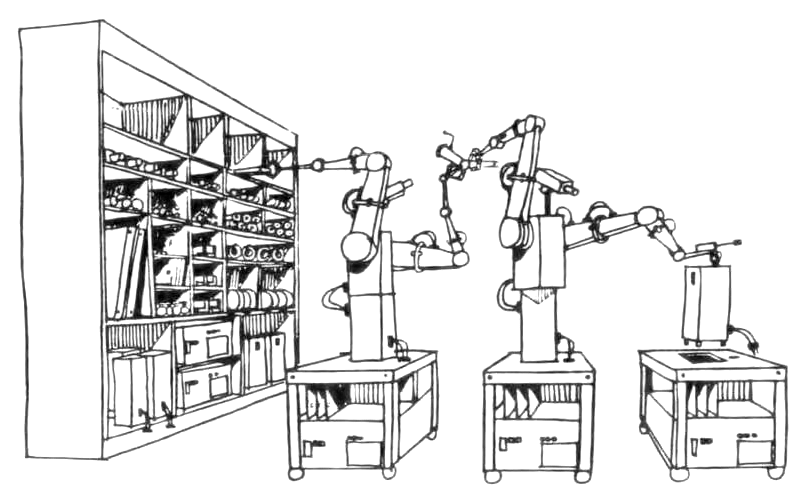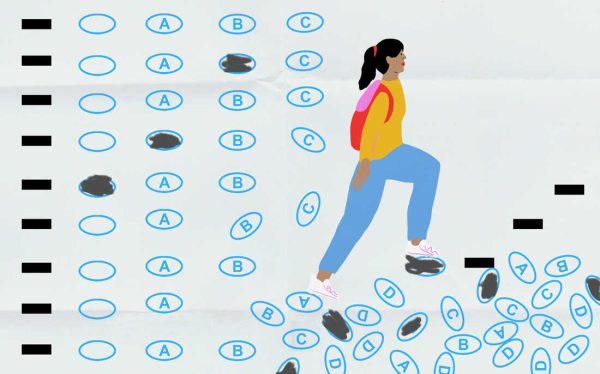What is the Future of Blue and White Collar Jobs?
Since the industrial revolution, the idea of automation had already existed, becoming a reality starting around 1980. According to data collected by Business Insider “between 50% and 70% of changes in US wage structure since the 1980s are linked to pay declines in industries experiencing rapid automation… groups facing the highest levels of task displacement also saw their real wages fall the most.” Automation has affected jobs and pays for a generation seeing the first glimpses of automation and algorithms, today’s young generations are now facing an ever-growing threat including a new arrival, Artificial intelligence specifically AI-powered algorithms and the rising cost of tuition has not helped as the average college senior graduate has around $30,000 in student loan debts according to Forbes. All of this will weigh heavily on the future of traditional blue and white-collar jobs as the barriers to entry rises for a college education so will the demand for alternatives for high-skilled labor as fewer graduate college-educated in critical applications and more people turn to low-skilled work fuelling an already ever-increasing incentive for total automation.
College tuition has increased since the late 1980s. CNBC reported that tuition for 1987-88 was an average of $15,160 for private non-profit institutions and $3,190 for public institutions in 2017 dollars compared to $9,970 for public institutions and $34,740 for private non-profit institutions for 2017-2018 according to CNBC.
Based on data from Walden University, around 30% of teens are employed while enrolled in high school. This could mean 90 out of every 301 students at our school have jobs, they typically work in the low-wage service sector e.g. Waiters/Waitresses, Delivery drivers, Cashiers, Servers, etc. In Colorado, 91.7% of citizens have a high school degree, 42.7% have a bachelor’s degree, and 16% have a master’s degree or higher, which is higher than the national average of 88% of citizens having a high school diploma, 33.1% have a bachelor degree, 12.8% have a masters degree or higher according to the U.S. Census Bureau.
Why is it all-important?
According to the Brookings Institute, the jobs below face some of the highest exposure to AI in the near future:
- Chemical engineers (median salary: $104,910 per year) typically require a bachelor’s degree
- Political scientists (median salary: $117,570 per year) typically require a doctorate
- Nuclear technicians (median salary: $79,140 per year) typically requires an associate’s degree
- Physicists (median salary: $120,950 per year) typically require a Doctoral degree
- Occupational therapists (median salary: $84,270 per year) typically requires a Bachelor degree
- Gas plant operators (median salary: $83,020 per year) typically require a high school diploma
- Administrative law judges, adjudicators, and hearing officers (median salary: $94,790 per year) typically require a doctorate
- Well-paid managers, supervisors, and analysts, typically require a bachelor’s degree
Notice anything particular about these jobs? Seven out of eight of these jobs require a college degree. According to CNBC, “Workers who hold a bachelor’s degree, for example, would be exposed to AI over five times more than those with only a high school degree. That’s because AI is especially good at completing tasks that require planning, learning, reasoning, problem-solving and predicting — most of which are skills required for white-collar jobs.” In the United States according to Vox, about 700,000 people work as market research analysts, their job growth according to the Bureau of Labor Statistics is much higher than average. However, they are more likely to overlap with AI patents on average, in fact, some market-research analysts have begun to contend with artificial intelligence in their jobs, but luckily so far this artificial intelligence has been used to only assist their work so they can become more productive in their tasks.
This is also occurring in other fields, not just market-research analysts, “White-collar workers in fields like journalism, finance, medicine, and law are seeing an increasing use of machines,” according to Business Insider. Such machine learning systems have human radiologists and pathologists beat, even outperforming them at interpreting medical images in some cases. Blue-collar jobs typically are physical and routine work, which explains the gap between artificial intelligence exposure between them. Instead, “Robotics and software, are likely to impact the physical and routine work of traditionally blue-collar jobs.” according to CNBC.
What is at risk?
In a report by McKinsey & Company, “projects that up to 800 million global workers could be replaced by robots by 2030. For the most part, the report found that blue-collar jobs, such as machine operating and fast food preparation, are especially susceptible to disruption” which would mean 9.75% of the people around the world would be out of work. Using this percentage we can make an educated guess that 32.13 million U.S. citizens would be affected by this disruption in blue-collar jobs.
An analysis was done by Stanford University doctoral candidate Michael Webb had found an “overlap between more than 16,000 AI-related patents and more than 800 job descriptions and found that highly-educated, well-paid workers may be heavily affected by the spread of AI” as was the case with J.P. Morgan that had announced that they were using COIN (Contract Intelligence) that can quote “accomplish in seconds what it took legal aides 360,000 hours of work to do”. That wasn’t the only case of this happening either, “Japan’s Fukoku Life Insurance Co. recently turned to IBM technology to automate document processing” we should expect more AI-related patents to displace more white-collar workers in the future rather than blue-collar jobs which are likely themselves to be displaced by robotics and software.
As is the case with the announcement of a robot car delivery service by Dominos, “The robots are coming, and they’re bringing pizza. This week, Domino’s is rolling out a robot car delivery service to select customers in Houston. For those who opt-in, their pies will arrive in a fully autonomous vehicle made by Nuro.”, Dennis Malony, Domino’s Senior Vice President and Chief Innovation Officer, said in a statement to CNN, “This program will allow us to better understand how customers respond to the deliveries, how they interact with the robot, and how it affects store operations”. According to an investigation by CNN, “Domino’s isn’t the first pizza chain to play around with this technology. In 2018, Pizza Hut announced that it was working with Toyota to release a fully autonomous delivery vehicle” as expected with healthy competition, though this is concerning whose primary work is delivering food.
Speaking of robot cars, Tesla had announced that “As Tesla’s self-driving technology continues to improve, those vehicles will become self-driving robotaxis, allowing users to go from 12 hours a week to 60 hours a week. Tesla could charge additional fees for those robotaxis, allowing the company to generate much more revenue per car. Basically, it would be like bringing software economics to the manufacturing-intensive car business” in an explanation to Investors by Elon Musk to justify Tesla’s valuation of $800B.
How is this happening
Generally, high skilled workers tend to have tasks that involve judgment and optimization, As Webb told CNBC “Optimizing ads as an online marketer or a radiologist interpreting medical scans, all of these things take a long time for humans to be good at them. But when it comes to algorithms, once you have the right training data, they tend to be better than humans” that means as more data becomes available it can soon make decisions on par with humans then eventually use real-time data through machine learning. This is important because for someone like Google, which owns Youtube that receives 500 hours of video per minute. That is impossible for a human being to analyze to find videos that are possibly breaking the youtube guidelines. Is for that reason why we see so many complaints to Youtube that their videos were mistakenly taken down because it is an algorithm that analyzes the data, not humans. As such it does not have the capacity for human nuances, only literal interpretation.
Why we shouldn’t worry
In an interview with CNBC, Anima Anandkumar, director of machine learning research at Nvidia, a maker of graphics processing units, said, “The thought that robots are stealing our jobs is nonsense… workers should evaluate the future of their own roles by asking three questions: Is my job fairly repetitive? Are there well-defined objectives to evaluate my job? Is there a large amount of data accessible to train an AI system?”
Essentially what Animakumar is trying to convey is that AI exposure is the direct result of a lack of creativity and human intuition and that workers should aim for jobs that require these qualities. However, not all AI exposure is bad, according to David Autor at the MIT Sloan School of Business and a leading expert on the issue of jobs and automation in an interview with CNBC, “Automation does indeed substitute for labor—as it is typically intended to do,” Autor writes. “However, automation also complements labor, raises output in ways that lead to higher demand for labor, and interacts with adjustments in labor supply.”
This means that automating basic tasks such as animated movement would provide a boost in productivity because they would only have to select points A and B, which is a big deal. Why? Imagine spending days trying to perfect a jump between a gap to look “natural” and only hours actually making an immersive experience and story. Wasted potential for creativity just to make one action in a game which the player won’t pay that much attention to. With AI animated movement would generate variations of the same movement if the first one doesn’t fit in the game, which means days otherwise spent animating could be instead used in the development cycle for story writing and creative game modes for the player to enjoy.
However, not all agree with this point of view as with the case with Treasury Secretary Steve Mnuchin who “came under fire recently for saying he was not at all concerned about automation “It’s not even on our radar screen … 50 to 100 more years” away, he said, in an interview with Axios. “I’m not worried at all” about robots displacing humans in the near future. “In fact, I’m optimistic”. A mere look at the growing share of market trades done by electronic algorithms rather than humans should tell the secretary something about the pace of change in banking. And computer-generated imagery has completely redrawn the landscape of cinematic possibility, including using fewer actors and costume and stage designers, even for large, epic scenes“ which is odd according to Business Insider and to some insensitive because of his background “as a longtime Goldman Sachs banker and later Hollywood film executive, considering that both industries have all but been revolutionized by technological change in just the past decade.”
Although Mnuchin is kind of right in seeing Artificial Intelligence as an opportunity rather than a threat according to a survey done by PwC Chief Economist John Hawksworth and Richard Berriman, a machine learning specialist at the firm, “Automation will also boost productivity and wealth, leading to offsetting additional job gains elsewhere in the economy — but inequality may rise.”
Which would mean jobs lost will be offset by the jobs gained in other parts of industries or unknown new needs for more jobs. Along with the traditional boost in productivity and wealth that comes with new technology in those industries.









